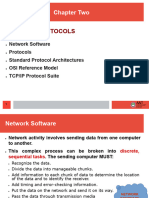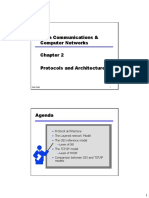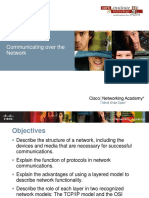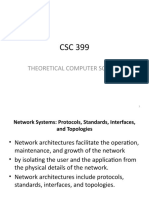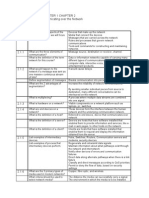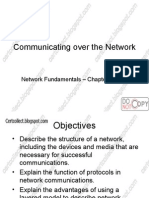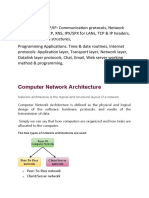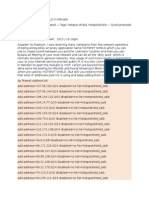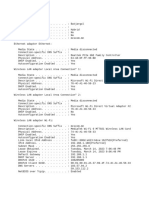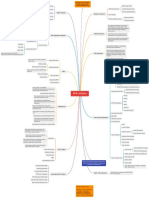Characteristics of communication
system:
Delivery, accuracy, timeliness, and jitter.
Delivery. The system must deliver data to the correct destination. Data must be received by the
intended device or user and only by that device or user.
Accuracy. The system must deliver the data accurately. Data that have been altered in
transmission and left uncorrected are unusable.
Timeliness. The system must deliver data in a timely manner. Data delivered late are useless. In
the case of video and audio, timely delivery means delivering data as they are produced, in the
same order that they are produced, and without significant delay. This kind of delivery is called
real-time transmission.
Jitter. Jitter refers to the variation in the packet arrival time. It is the uneven delay in the
delivery of audio or video packets.
�Network Structure
Where communication begins?
Communication begins with a message, or information, that must
be sent from one individual or device to another.
People exchange ideas using many different communication
methods. All of these methods have three elements in common.
message source
the channel
message destination
�Network Structure
how messages are communicated?
A better approach of message communication is to divide the data into
smaller, more manageable pieces to send over the network. This
division of the data stream into smaller pieces is called segmentation.
Data is sent across a network in small chunks called segments
�Network Structure
The components of a network
The path that a message takes from source to destination can be as simple as a single cable
connecting one computer to another or as complex as a network that literally spans the
globe.
Network components are build up of:
hardware and software.
Devices and media are the physical elements or hardware of the network.
Services and processes are the communication programs, called software,
that run on the networked devices.
�Network Structure
What are the END Devices and their Role in the Network?
The network devices that people are most familiar with are called end devices.
These devices form the interface between the human network and the
underlying communication network. Some examples of end devices are:
Computers (work stations, laptops, file servers, web servers)
Network printers
VoIP phones
Security cameras
Mobile handheld devices (such as wireless barcode scanners, PDAs)
Servers are hosts that have software installed that enables them to provide
information and services, like e-mail or web pages, to other hosts on the network.
Clients are hosts that have software installed that enables them to request and
display the information obtained from the server.
�Network Structure
End devices form interface with human network & communications network
Role of end devices :
client
server
both client and server
�Network Structure
What are the role of an intermediary device in a data network?
Networks rely on intermediary devices to provide connectivity and to work
behind the scenes to ensure that data flows across the network.
These devices connect the individual hosts to the network and can connect
multiple individual networks to form an internetwork.
Examples of intermediary network devices are:
Network Access Devices (Hubs, switches, and wireless access points)
Internetworking Devices (routers)
Communication Servers and Modems
Security Devices (firewalls)
�Network Structure
Role of an intermediary device
provides connectivity and ensures data flows
across network
�Network Structure
network media and criteria for making a network media choice
Communication across a network is carried on a medium. The medium provides
the channel over which the message travels from source to destination.
Network media
this is the channel over which a message travels
�Network Types
Networks infrastructures can vary greatly in terms of:
The size of the area covered
The number of users connected
The number and types of services available
The Local Area Networks (LANs)
A network serving a home, building or campus is considered a Local Area
Network (LAN)
�Network Types
The Wide Area Networks (WANs)
- LANs separated by geographic distance are connected by a network known
as a Wide Area Network (WAN)
�Network Types
Define the Internet
The internet is defined as a
global mesh of interconnected networks
�Network Types
The network representations
�Network Interfaces
In addition to these representations, specialized terminology is used
when discussing how each of these devices and media connect to each
other. Important terms to remember are:
Network Interface Card - A NIC, or LAN adapter, provides the physical
connection to the network at the PC or other host device. The media
connecting the PC to the networking device plugs directly into the NIC.
Physical Port - A connector or outlet on a networking device where the
media is connected to a host or other networking device.
Interface - Specialized ports on an internetworking device that connect
to individual networks. Because routers are used to interconnect
networks, the ports on a router are referred to network interface
�Function of Protocol in Network Communication
A protocol is a set of predetermined rules
All communication, whether face-to-face or over a network, is governed by
predetermined rules called protocols.
These protocols are specific to the characteristics of the conversation.
�Function of Protocol in Network Communication
The network protocols
Network protocols are used to allow devices to communicate successfully
�Function of Protocol in Network Communication
Describe Protocol suites and industry standards
A standard is
a process or protocol that has been endorsed by the networking industry and
ratified by a standards organization, such as the Institute of Electrical
and Electronics Engineers (IEEE) or the Internet Engineering Task
Force (IETF).
�Layers with TCP/IP and OSI Model
The TCP/IP Model
�Layers with TCP/IP and OSI Model
Describe the Communication Process
�Layers with TCP/IP and OSI Model
Explain protocol data units (PDU) and encapsulation
As application data is passed down the protocol stack on its way to be
transmitted across the network media, various protocols add information to it at
each level. This is commonly known as the encapsulation process.
The form that a piece of data takes at any layer is called a Protocol Data Unit
(PDU). During encapsulation, each succeeding layer encapsulates the PDU that it
receives from the layer above in accordance with the protocol being used.
�Layers with TCP/IP and OSI Model
Explain protocol and reference
models
A protocol model
provides a model that
closely matches the
structure of a particular
protocol suite.
A reference model
provides a common
reference for maintaining
consistency within all
types
of network
protocols and
services.
�Addressing and Naming Schemes
how labels in encapsulation headers are used to manage
communication in data networks?
�Layers with TCP/IP and OSI Model
The Open Systems Interconnection reference model is a layered, abstract
representation created as a guideline for network protocol design.
The OSI model divides the networking process into seven logical layers,
each of which has unique functionality and to which are assigned specific
services and protocols.
In this model, information is passed from one layer to the next, starting at
the Application layer on the transmitting host, proceeding down the
hierarchy to the Physical layer, then passing over the communications
channel to the destination host, where the information proceeds back up
the hierarchy, ending at the Application layer. The figure depicts the steps
in this process.
The Application layer, Layer seven, is the top layer of both the OSI and
TCP/IP models. It is the layer that provides the interface between the
applications we use to communicate and the underlying network over which
our messages are transmitted. Application layer protocols are used to
exchange data between programs running on the source and destination
hosts.
�The Application Layer
The Application layer provides the interface to the network.
The application layer prepares human communication to be transmitted over
the data network.
�The Presentation Layer
The Presentation layer has three primary functions:
Coding and conversion of Application layer data to ensure that data from the source device can
be interpreted by the appropriate application on the destination device.
Compression of the data in a manner that can be decompressed by the destination device.
Encryption of the data for transmission and the decryption of data upon receipt by the
destination.
The Session Layer
As the name of the Session layer implies, functions at this layer create and maintain dialogs
between source and destination applications.
The Session layer handles the exchange of information to initiate dialogs, keep them active, and
to restart sessions that are disrupted or idle for a long period of time.
�The Transport Layer:
The transport layer prepares the application data for transport over the
network and process the network data for use by application.
�The Role of Transport Layer
The Transport layer provides for the segmentation of data and the control
necessary to reassemble these pieces into the various communication streams.
Its primary responsibilities to accomplish this are:
Tracking the individual communication between applications on the source
and destination hosts
Segmenting data and managing each piece
Reassembling the segments into streams of application data
Identifying the different applications
�Network Layer Protocols and Internet Protocol (IP)
The basic role of the Network Layer in data networks
The Network layer encapsulation allows its contents to be
passed to the destination within a network or on another
network with minimum overhead.
To accomplish this
end-to-end transport,
Layer 3 uses four
basic processes:
Addressing
Encapsulation
Routing
Decapsulation
�The Data Link Layer
The data link layer provides a means for exchanging data over a common
local media.
�Data Link Layer Accessing the Media
why Data Link layer protocols are required to control media access?
�The Data Link Layer
The Data Link layer provides a means for exchanging data over a common local
media.
The Data Link layer performs two basic services:
Allows the upper layers to access the media using techniques such as framing
Controls how data is placed onto the media and is received from the media
using techniques such as media access control and error detection
�Data Link Layer Accessing the Media
Describe the role the Data Link layer plays in linking the software and hardware
layers
The Data Link layer exists as a connecting layer between the software processes
of the layers above it and the Physical layer below it. As such, it prepares the
Network layer packets for transmission across some form of media, be it copper,
fiber, or the atmosphere.
�Data Link Sublayers
To support a wide variety of network functions, the Data Link layer is often
divided into two sublayers: an upper sublayer and an lower sublayer.
The upper sublayer defines the software processes that provide services to
the Network layer protocols.
The lower sublayer defines the media access processes performed by the
hardware.
�The two common LAN sublayers are:
Logical Link Control
Logical Link Control (LLC) places information in the frame that identifies which Network
layer protocol is being used for the frame. This information allows multiple Layer 3
protocols, such as IP and IPX, to utilize the same network interface and media.
Media Access Control
Media Access Control (MAC) provides Data Link layer addressing and delimiting of data
according to the physical signaling requirements of the medium and the type of Data
Link layer protocol in use.
�Physical Layer Protocols & Services
Purpose of the Physical Layer
The role of the OSI physical layer is to encode the binary digits that represent
data link layer frames into signals and to transmit and receive these signals
across the physical mediacopper wires, optical fiber, and wirelessthat
connect network devices.
�Purpose of Physical Layer
To prepare a data-link frame for the journey across the medium, the physical layer
encodes the logical frame with patterns of data that will make it recognizable to the
device that will pick it up on the other end of the medium. The device can be a router
that will forward the frame or the destination device.
The delivery of frames across the local media requires the following physical layer
elements:
The physical media and associated connectors
A representation of bits on the media
Encoding of data and control information
Transmitter and receiver circuitry on the network devices
After the signals traverse the medium, they are decoded to their original bit
representations of data and given to the data link layer as a complete frame.




